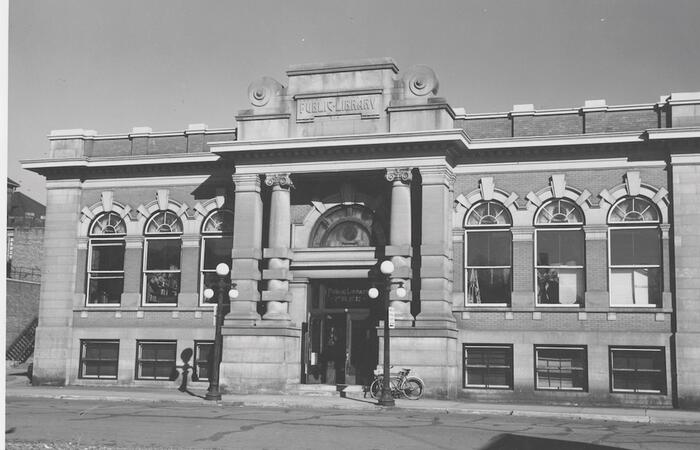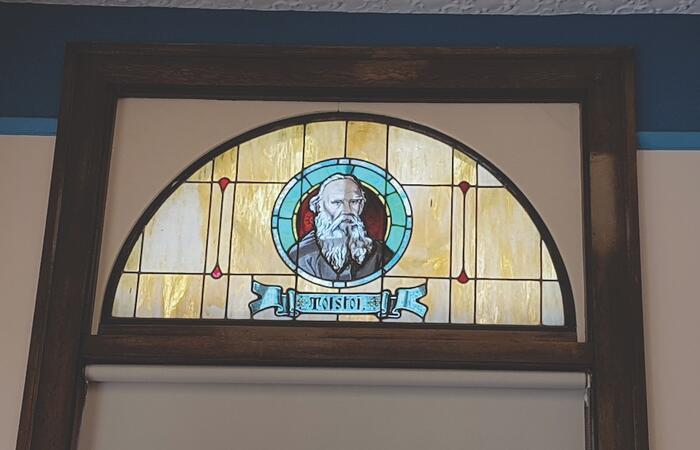There is not such a cradle of democracy upon the Earth as the Free Public Library – Andrew Carnegie
When we visit the library, do we think of its history? When did it first open? Who was involved in its founding? How has it changed throughout the years? Our libraries are institutions that play an essential role in our society. They are places of creativity, of local and worldwide connections and are the centres of our community. Over 23,000 librarians and library clerks serve in 22,000 libraries across Canada. But just 120 years ago, libraries were not nearly as prevalent. In the late 1800s, there were only a few libraries in existence and you had to pay a fee to use them. This meant that only well to do people could afford to “borrow” from them. The first library in the Lakehead was started by the Canadian Pacific Railway in 1885 located in their roundhouse. CPR employees had to pay an annual fee of $1.25 to use it. Non-employees were charged $0.25 more. In 1905, the library was moved to the basement of the Fort William city hall until 1912 when the Brodie St. library opened.
Andrew Carnegie (1835 - 1919) was born into an impoverished family in Scotland. He immigrated to Pennsylvania as a young man. He amassed a fortune working in the steel industry of what would be $372 billion today making him one of the richest men in the world. Carnegie’s conviction was that any man of wealth who dies rich does so in disgrace. True to his word, after accumulating his fortune, he gave it all away through works of philanthropy. He said the men and women who had worked in the steel industry where he acquired his wealth should have it back. Carnegie is known for his generosity donating millions to schools, churches, societies and charities. What Andrew Carnegie is best remembered for is his grants to build public libraries the world over. From 1883 to 1929, Carnegie built 2,509 libraries. Of those, 125 were in Canada with one being in Fort William, Ontario. To receive the grant, certain requirements had to be met. The building had to conform to an architectural style, the library had to be maintained by the grant recipient and the use of the library had to be free for anyone. Some of the building styles were Romanesque Revival, Queen Anne Revival and Georgian Classical. The Brodie St. library was designed in the ornate Beaux Arts/Neoclassical style. All the libraries had stairs leading up into them to symbolize elevating one’s self through the acquisition of knowledge.
In 1908, the Fort William Public Library received a grant of $50,000 from the Carnegie Foundation to construct and stock a public library. The local architects Scott and Hood were commissioned to design the building. Scott and Hood incorporated stained glass fan lights at a cost of $50.00 each into the design. They depict popular authors of the day and are unique to the library. On April 29, 1912, the Brodie St. location of the Fort William Public Library opened. Mary J.L. Black, who served as librarian since 1909 was appointed head librarian.
Since it opened, Brodie St. library has served its community in many ways. During the flu epidemic of 1918, its reading room was converted into a hospital ward to assist McKellar Hospital. The library billeted men in 1940 who had just enlisted in the Lake Superior Regiment. Brodie St. library was the home of the Thunder Bay Historical Society Museum from 1941 to 1972. The National Film Board of Canada had an office there from 1947 to 1967. In 1938, a branch library designed by Scott and Hood located at the corner of Brock and Brown streets was opened. It was named in honour of Mary J.L. Black who had retired the previous year. By the 1950s, Brodie St. library had grown and needed more space. Scott and Hood designed an extension and it was opened in 1955. With amalgamation in 1970, Port Arthur and Fort William Public Libraries merged to form the Thunder Bay Public Library and the Brodie St. library became the Brodie Resource Library. On February 27, 1982, Brodie Resource Library was declared a historically significant building by the City of Thunder Bay and a commemorative plaque mounted on the wall inside the front door.
Throughout all that has happened over the years since it opened, Brodie Resource Library has been an institute of learning and a hub of community activity. It has adapted to serve the changes in our society and will continue to change as we do.
The services Brodie Resource Library provides are numerous. It loans books, CDs and DVDs. At one time it loaned paintings and films. The library holds workshops for young and old alike, conducts community outreach programs and partners with local organizations. You can research historical documents on microfiche or from its archives. The library provides space for local organizations to meet, or for people to come and read a newspaper, magazine, study or use a computer. Brodie Resource Library is an integral part of the fabric of our community.
When you walk through the doors of the Brodie Resource Library, feel a sense history, of the century of service it has provided to the citizens of Thunder Bay and the many generation of people it has served. Look up at the fan lights and behold works of art that you won’t see anywhere else. Brodie Resource Library is a gift for all of us to use. It is our Carnegie library.





